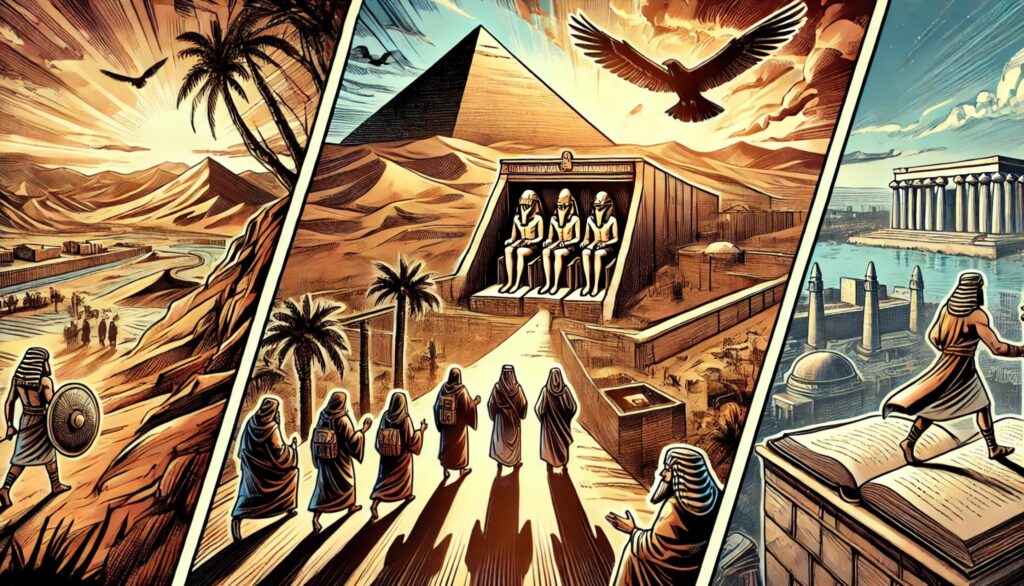The Power of Place: How Biblical Settings Shape the Story
If you’ve ever watched a movie or read a novel, you know that the setting plays a crucial role in shaping the story. A dark alley at midnight sets a different tone than a sunny meadow at noon. A courtroom hints at justice and judgment, while an old abandoned house prepares you for something eerie. Authors use settings to create expectations, and biblical writers were no different.
In fact, biblical authors were literary masters, crafting stories where locations weren’t just background scenery—they carried deep meaning, evoking memories and setting the stage for key moments in God’s plan. If we learn to recognize these patterns, we’ll begin to see the Bible in an entirely new way.
Egypt: A Place of Trouble and Redemption
One of the most recognizable settings in Scripture is Egypt. When we hear “Egypt” in a biblical story, our minds should immediately recall themes of trouble, oppression, and deliverance.
The first major Egypt story involves Abraham. God called him to a new land and promised him a family as numerous as the stars. But when famine hit, instead of trusting God, Abraham left the Promised Land and went to Egypt to find food. That decision led to disaster—he lied about his wife Sarah, Pharaoh took her into his palace, and things spiraled downhill. But then, God intervened. He sent plagues on Pharaoh’s house, and Abraham and Sarah left Egypt—wealthier than before but having learned a valuable lesson.
Now, once we’ve seen Egypt as a place of both bad decisions and divine rescue, we should expect that theme to repeat. And it does.
A few generations later, Abraham’s descendants—Jacob’s sons—find themselves in another famine, which again leads them to Egypt. This time, they stay and multiply, only to end up enslaved for generations. Once again, God rescues his people with plagues, and they leave Egypt with great wealth. The pattern continues.
After the Israelites finally make it back to their own land, God warns them: “Never go back to Egypt.” But do they listen? No.
King Solomon, at the height of his power, makes an alliance with Egypt, marries Pharaoh’s daughter, and starts importing Egyptian warhorses. Big mistake. Within a generation, Egypt is oppressing Israel again, just like before.
So, when biblical characters return to Egypt, it’s a signal to the reader: things are going to go wrong. But then, the Bible does something unexpected.
In the Gospel of Matthew, when King Herod is hunting for baby Jesus, his family flees to Egypt for safety. Wait…what? Isn’t Egypt supposed to be the place of oppression? But notice—this time, the real villain is in Jerusalem, not Egypt.
Matthew is showing us that Jerusalem has become the new Egypt—the place of power-hungry rulers oppressing God’s people. It’s a brilliant reversal of expectations, designed to make us rethink what we assume about the setting.
Patterns in Places, Movements, and Time
Biblical settings aren’t just about where a story takes place—they’re also about how people move and how long things take. These patterns build up meaning across the biblical narrative.
Eastward Movements: A Sign of Trouble
In biblical stories, moving east is often a bad sign.
- Adam and Eve are exiled east of Eden after their sin.
- Cain murders his brother and then wanders even further east.
- The people of Babel build their rebellious tower in the east.
- And centuries later, Israel is exiled east to Babylon as punishment for their sins.
When people move east, things fall apart. But this pattern isn’t just about geography—it’s a storytelling device that clues us into deeper spiritual realities.
Forty: The Number of Testing
Another common pattern in biblical settings is the number forty, which represents a time of testing and transformation.
- Noah is in the ark for forty days before the floodwaters recede—yet after leaving, he immediately falls into sin.
- Moses goes up Mount Sinai for forty days, but while he’s gone, the Israelites make a golden calf and rebel.
- The Israelites wander the desert for forty years, struggling to trust God.
Each of these “forty” moments marks a time when someone’s faithfulness is put to the test—and they usually fail. But then comes Jesus.
Before beginning his ministry, Jesus is tested in the wilderness for forty days. But unlike everyone before him, he passes the test. Instead of failing like Noah, Moses, and Israel, Jesus resists temptation and remains faithful.
By recognizing this forty-day pattern, we see that Jesus is the one who finally breaks the cycle of failure and sets a new trajectory for humanity.
Why This Matters for Us
When we read the Bible, paying attention to where stories take place, where people move, and how long things last helps us unlock deeper meaning.
- If someone goes to Egypt, we should brace for trouble (but also expect God’s rescue).
- If someone moves east, we should watch for rebellion and separation from God.
- If something lasts forty days or years, we should expect a season of testing.
These patterns are no accident—they are intentional literary devices that biblical authors used to communicate profound truths. And the New Testament writers use these same settings to show how Jesus is leading us out of exile, slavery, and wilderness, and into new creation.
So next time you read a biblical story, take a moment to ask: Where is this happening? What does this setting remind me of? Is there a pattern at play? The answers might just change how you see the Bible forever.

